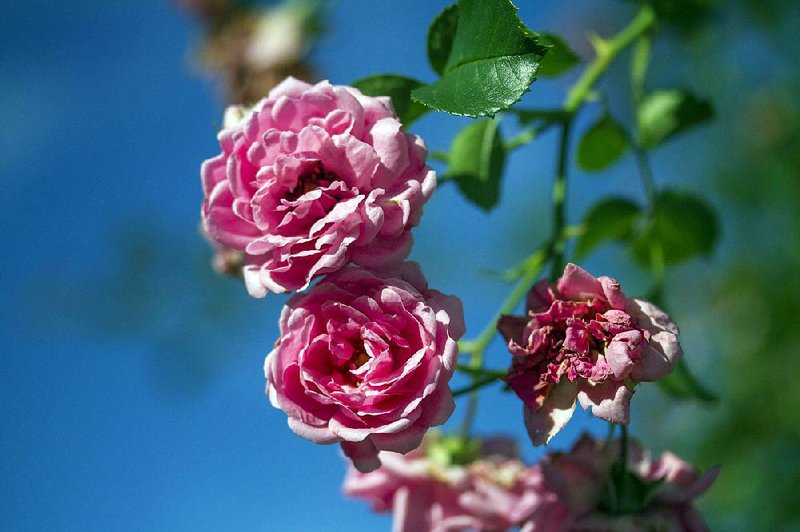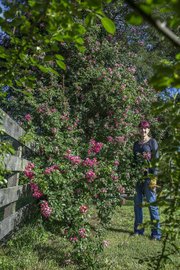The rose lends itself to plant breeding as willingly as its cousin the apple, and gardeners have been trying to find the next perfect rose for centuries. In recent years this tinkering has reached a new pitch as breeders, growers and nurseries have frantically sought to reinvent the rose and reshape its image as a sickly and fussy plant.
To a great extent they have succeeded, developing roses that bloom continually into fall and don't need spraying. The shining example is the Knock Out rose, planted by the millions and defining office parks, hotel parking lots and home gardens where the owner doesn't want to fuss with the plant life. Knock Out succeeds wildly as a bulletproof flowering shrub, but the plant is stiff in its habit and the off-key magenta bloom is hard to love. It is not the rose of Shakespeare sonnets.
But there is a rose worthy of such poetic devotion and one that has stayed above the fray of the breeding revolution. This is the rambling rose -- the spreading, luxuriant rose of arbors, trellises and pergolas that is so decadent in its vigor, flower count, colors, fragrances and sheer elan that it almost dares you to declare it old-fashioned.
The rambler is not old-fashioned; it's timeless. I can think of no other single plant that can lend an area of the garden so much drama, romance and character.
So why doesn't everyone have one? They can be hard to find, and they require some work, but the biggest drawback is that they bloom just once a year. A single bower may be in flower for a month, and extravagantly even for a rose, but those attributes don't wash for consumers programmed for ever-blooming roses.
THEY LOOK GREAT
We don't fret when the dogwood blooms but once a year, or the clematis or the viburnum. We should allow room in our hearts -- and gardens -- for ramblers, and you don't need a thatched, low-eaved cottage to get the effect. I have two growing on a utilitarian fence around my community garden plot. By any objective measure, they look great, especially the French heirloom named Alexandre Girault, dripping from mid-May to mid-June with hundreds of scented, crimson-pink blooms.
The lateral branches extend 25 feet, and the embrace would be more encompassing if I allowed it. Once the blooms fade, I spend about an hour cutting off all the spent flowers and then 10 minutes once a week through the summer trimming back the vegetative growth to keep it tidy-looking and clear of the adjoining path. Even if I viewed this work as a chore rather than as horticultural therapy, it would still be worth it for the annual display. I don't spray it against black spot or anything else, and the foliage remains clean and disease-free.
Climbing roses, in comparison to ramblers, tend to bloom repeatedly through the season, but are shorter and with stiffer canes.
One rose lover who needs no convincing is Connie Hilker, who lives in an 1848 brick Gothic house in the Stafford County, Va., hamlet of Hartwood. The property, once part of a 1,150-acre antebellum estate, has nine acres of land adorned with old trees and charming outbuildings, and is wrapped in a paddock fence that serves as a gallery wall for her picture-perfect rambling roses.
NEW DAWN
A rose named Dr. W. Van Fleet was particularly festive when I visited recently. This is one of the best-known and most enduring rambling roses, but its offspring (actually a mutation known as a sport) has become more famous as the ubiquitous climber we know as New Dawn. New Dawn is a great rose -- for one thing, it reblooms -- but its parent has the edge when it comes to rambling qualities. The canes are more pliant and the rose is covered in so many soft pink blossoms that the petals, when they fall, turn the ground a blushed white.
Hilker, who is on a mission to collect and preserve antique rose varieties in danger of being lost, has a handful of lesser-known roses introduced by the Van Fleet rose's namesake, Walter Van Fleet, including Alida Lovett, which is shell pink, vigorous and less thorny than most.
Behind the house, down the hill past the ancient pecan tree (with a spread of more than 100 feet), she has used the perimeter fence to present other ramblers. Here, she grows them in a more open style in which the lateral branches are fewer but allowed to grow long, and each one is peppered with blooms. Think of them as strings of festive lights, glowing in their rich colors and fragrances. One reason to grow roses laterally rather than just up: Horizontal growth encourages greater flowering along a branch.
She shows me one especially winsome rose, a variety named Leontine Gervais, with semidouble, glowing pink blooms and a conspicuous orange boss of stamens. At just three years in the ground here, it was already more than 40 feet across, though just five feet in height. This is the beauty of ramblers: The gardener determines the height and then lets them spread far and wide.
PRUNING REGIMEN
To grow them so low and openly, Hilker follows a methodical pruning regimen. They bloom on canes that developed the year before; the young shoots now growing at the base of the shrub will bear flowers next year. Those that are growing roughly in the right direction will be kept and tethered along the fence, and those that cannot be wrangled will be removed. Espaliered this way, no more than six lateral branches remain on each side. As the new canes are tied and trained, the oldest ones will be removed.
You don't have to be this methodical about the pruning if you want a fuller, wilder look. Having established the lateral growth on my Alexandre Girault, I prune it to the width I want and remove congested canes in the winter. It is trimmed over the summer but I avoid the type of hard pre-spring pruning you would on a shrub rose to keep flower-bearing branches.
If you want a corner of your garden to look romantically brambly, you can do no pruning. This is in play with a fetching feral rose that Hilker has allowed to populate a corner of the property. Named Arcata Pink Globe, it sprawls itself like a languid diva over a fence and adjoining shrubbery. The flowers are four inches across, layered in soft pink petals and sweetly scented. The Arcata Pink Globe is due to be tamed, but Hilker will wait until next winter because it is currently supporting wildlife, including nesting cardinals.
Another way to go wild with ramblers is to allow them to grow into trees, an effect that needs the most robust of the gang. Hilker has American Pillar clambering up a red cedar tree and a Paul's Himalayan Musk lurking in a black cherry tree. Other giants used in this role include the early May-flowering Banksian rose (white and yellow versions), Mrs. Keays's Snowbush and the Kiftsgate rose.
LIMITS THEIR ROLE
Many ramblers are lax in their petal arrangements and their stems. This to my eye increases their charm, although the floppiness limits their role as cut flowers. In the vase they need propping up and don't last that long. Maybe this is why Hilker prefers the more single and semidouble varieties. I keep meaning to plant the variety Francis E. Lester, which has large single blooms that are soft pink with contrasting yellow stamens. Dortmund is another vigorous scene-setting single bloomer with vibrant red flowers.
The essential consideration when growing ramblers is to make sure the structure they are growing on is strong and large enough for the task. "You see people with wimpy trellises or arches, and the next thing you know you're having to dodge the roses," said Nancy Moitrier, a gardener and landscape designer from Annapolis, Md. "It's terrible if the rose collapses."
This need for heft goes beyond the load-bearing physics and into the realm of design. The supporting structure is the rose's full partner in the performance and together they create the character of their space. "When it's strong enough, it reads as a destination," said Gordon Hayward, a garden designer and author who lives in Putney, Vt. "That's where a rambling rose comes into play, because nothing beats the drama of the rose."
RELATED ARTICLE
http://www.arkansas…">Sources for roses of the old school
HomeStyle on 07/07/2018


